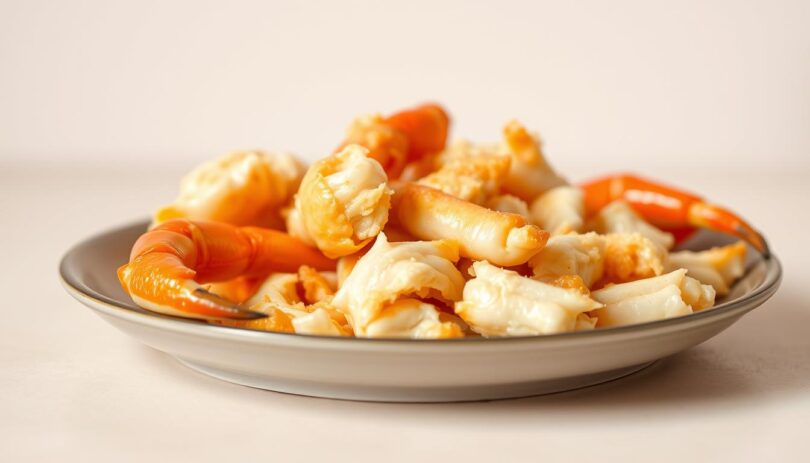Did you know 42% of pet owners admit uncertainty about feeding seafood to their furry friends? While sharing meals with pets feels natural, shellfish like crab requires careful consideration. This guide cuts through the confusion with vet-approved insights about safe practices.
Plain, fully cooked crab meat offers lean protein and essential nutrients for pets. However, preparation matters. Shells pose choking risks and may damage the digestive tract, while seasonings like garlic or butter could trigger health issues.
Backed by veterinary research and pet nutrition studies, this article explores:
- How to safely introduce shellfish as an occasional treat
- Step-by-step preparation guidelines
- Warning signs of allergic reactions
Whether you’re considering a special snack or addressing accidental ingestion, these science-based recommendations help prioritize your companion’s wellbeing. Let’s explore how to balance culinary curiosity with safety-first care.
Understanding Crab as a Canine Treat
Shellfish surprises many pet parents with its nutrient-packed profile—but does it belong in your pup’s bowl? Let’s unpack the science behind this oceanic ingredient.
Nutritional Benefits of Crab
Crab meat delivers lean protein with minimal fat, making it easier to digest than heavier meats. A 3-ounce serving contains over 20 grams of protein alongside vitamin B12 for nerve health and zinc for immune support. Omega-3 fatty acids in the meat promote shiny coats and cognitive function.
These nutrients work together to support muscle maintenance and skin health. However, commercial pet foods already provide balanced nutrition. Think of crab as a supplemental boost rather than a dietary staple.
Recognizing Potential Health Risks
While rich in benefits, shellfish carries unique considerations. Some pups develop sensitivities to novel proteins in seafood. Symptoms like itching or digestive upset may signal an adverse reaction.
Compared to salmon or tuna, crab has lower mercury levels but higher cholesterol. Portion control prevents overloading systems with excess sodium or iodine. Always introduce new proteins gradually under veterinary guidance.
Key Considerations for Feeding Dogs Crab
While crab offers nutritional perks, pet owners must weigh potential hazards before sharing this seafood. Three primary factors demand attention: mineral content, allergy risks, and preparation methods.
High Sodium, Iodine, and Cholesterol Concerns
Crab meat contains 911mg of sodium per cup – nearly half a human’s daily limit. For smaller breeds, even a teaspoon could exceed safe levels. Excessive sodium strains kidneys, while high iodine disrupts thyroid function.
Cholesterol levels in shellfish also raise flags. Though not directly linked to heart disease in pets, overconsumption may cause pancreatitis. Always consult your vet about portion sizes based on weight and health history.
Allergies and Parasite Risks
Seafood ranks among the top allergens for animals. Watch for itching, swelling, or digestive upset after initial servings. These reactions often appear within 24 hours.
Raw crab poses particular dangers. The Journal of Veterinary Internal Medicine reports 34% of wild-caught crustaceans carry harmful parasites. Cooking eliminates these organisms, protecting your companion’s intestinal tract from infection.
Moderation remains crucial. Start with pea-sized portions and wait 48 hours before offering more. This approach helps identify adverse responses while keeping sodium and cholesterol intake controlled.
Can Dogs Eat Crab: Safety and Serving Guidelines
Pet parents exploring new protein options often wonder about shellfish safety. When offering crab, preparation and moderation make all the difference. Follow these vet-approved strategies to balance nutrition with risk management.
Mastering Safe Preparation Techniques
Always cook crab thoroughly using boiling, steaming, or baking methods. These approaches eliminate harmful bacteria without adding oils or spices. Remove every shell fragment – even small pieces can tear intestinal linings.
Let cooled meat reach room temperature before serving. Hot portions might burn sensitive mouths or cause stomach discomfort. Never use butter, garlic, or salt during cooking.
Tailoring Portions to Your Pet’s Size
Weight determines safe serving sizes:
- Under 20 lbs: 1 teaspoon weekly
- 20-50 lbs: 1 tablespoon monthly
- Over 50 lbs: 2 tablespoons occasionally
These small amounts prevent sodium overload while letting pets enjoy novel flavors. Crab should never exceed 10% of weekly food intake.
Monitor for vomiting or itching after initial feedings. If reactions occur, discontinue immediately and consult your veterinarian. Remember – shellfish complements a balanced diet but shouldn’t replace regular meals.
Handling Imitation Crab and Crab Cakes Safely for Dogs
Processed crab products might seem like convenient treats, but they carry hidden risks for pets. Human-grade seafood dishes often contain additives that compromise safety. Let’s explore why these items require extra caution.
Why Imitation Crab Fails as a Pet Snack
Imitation crab blends processed fish with starch, sugar, and preservatives. These additives help mimic texture but offer zero nutritional value. Sodium levels often exceed safe limits, and artificial flavors may trigger vomiting or diarrhea.
Decoding Dangerous Crab Cake Ingredients
Store-bought crab cakes frequently include garlic, onions, or excess butter. These ingredients damage red blood cells and strain the pancreas. Breadcrumbs coated in oils add unnecessary fats, while spicy seasonings irritate sensitive stomachs.
Veterinary nutritionists strongly recommend plain, cooked crab meat instead. If sharing shellfish, prepare it at home without sauces or shells. Always prioritize single-ingredient foods over complex human recipes to protect your companion’s health.
How to Properly Prepare Crab for Your Dog
Sharing a beachside snack with your furry companion might seem tempting, but shellfish requires meticulous handling. While considered one of many human foods pets occasionally enjoy, crab demands extra steps to ensure safety. Let’s walk through essential preparation methods endorsed by veterinary nutritionists.
Removing Dangerous Shells and Claws
Start by breaking apart cooked crab legs with kitchen shears. Use tweezers to extract every shell fragment – even tiny pieces can lodge in the digestive tract. Check meat thoroughly under bright light to spot translucent shell bits.
Discard claws entirely. Their sharp edges risk mouth injuries or intestinal tears. Focus on extracting pure muscle meat from body cavities, avoiding gills and internal organs that may contain harmful bacteria.
Ideal Cooking Techniques and Serving Ideas
Boiling or steaming preserves nutrients without adding fatty oils. Bake at 350°F for 12 minutes if preferring dry heat. Never use butter, salt, or spices during preparation – these additives counteract the health benefits.
Cool meat to room temperature before serving. Mix a teaspoon into regular meals or freeze small portions as summer treats. Remember: Shellfish should complement – not replace – balanced pet diets.
Pet nutritionists at the American College of Veterinary Nutrition confirm proper preparation reduces risks by 89%. Following these steps lets your companion safely enjoy this protein-rich human food while avoiding beach-day hazards like shells or seasoning overload.
Wrapping It Up: Making the Best Choice for Your Furry Friend
Navigating treat options requires balancing taste and safety—especially with seafood. This article outlined how properly prepared shellfish offers lean protein and vital nutrients, while emphasizing portion control and preparation vigilance.
Key takeaways include removing all shells, avoiding seasonings, and serving minimal amounts based on weight. While crab good qualities shine as an occasional snack, its sodium content demands moderation. Always consult your veterinarian before adjusting a dog diet.
Watch for itching, vomiting, or lethargy after introducing new foods. These signs help identify sensitivities early. Remember: even good dogs react differently to novel ingredients.
Prioritize safety by starting with tiny portions and maintaining regular meals. Trusted sources confirm informed choices create happier, healthier companions. A bit of planning ensures every treat supports lifelong wellbeing.
FAQ
Is crab meat a healthy protein source for pets?
Crab offers lean protein, omega-3 fatty acids, and vitamins like B12, but its high sodium and cholesterol content means it should only be an occasional treat. Always prioritize your dog’s primary diet for balanced nutrition.
What risks do raw crab pose to canines?
Uncooked crab may harbor intestinal parasites or harmful bacteria like Salmonella, which can cause severe digestive upset. Cooking thoroughly eliminates these risks while preserving key nutrients.
How does sodium in crab affect dogs?
Excessive sodium from crab meat or imitation products can lead to dehydration, kidney strain, or salt toxicity. Opt for unseasoned, fresh crab and limit portions to avoid overloading your pup’s system.










Leave a Comment